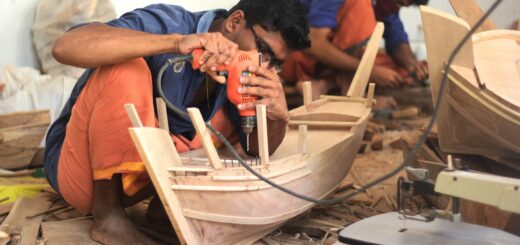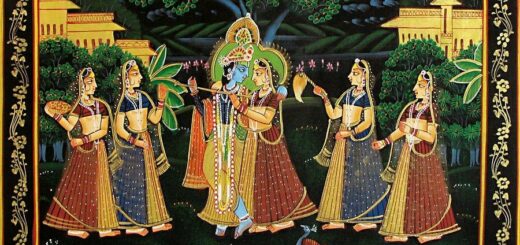Art & Culture: Buddhist Architecture
- The earliest historical sculpture in India is of the Mauryan age in the 4th-3rd centuries B.C. It is a bold and massive style marked by a certain realism freely employing foreign elements from Achaemenid Persia.
- The great Buddhist Emperor Ashoka caused the erection of monolithic pillars of sandstone, 30 to 40 feet high, crowned by animal figures like the bull, lion and elephant, and had them inscribed with the Buddhist concepts of morality, humanity and piety, which he wished his people to follow. Famous Ashokan pillars are from Lauriya Nandangarh in Bihar, Sanchi and Sarnath.
The Lion Capital
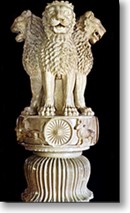
- The most remarkable of them all is the highly polished monolithic lion-capital found at Sarnath, which is now the Emblem of the Government of India.
- It represents four roaring lions back to back facing the four cardinal directions. The round abacus is decorated with four dharmachakras or wheels of law, alternating with an elephant, a bull, a horse and a lion, all carved with masterly skill.
- The abacus is supported by a bell-shaped base consisting of a lotus with dharmachakra, which perhaps symbolized the victory of righteousness over physical force. The superb modelling of the figures executed in a realistic manner with a certain stylization, is invested with a great power and dignity, and reveals the aristocratic and international nature of Mauryan art.
The Bull Capital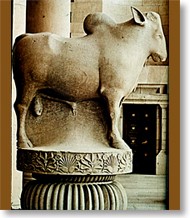
- The bull capital of Ashoka from Rampurva, Bihar, also belonging to the third century B.C. is an interesting study as it is a mixture of Persian and Indian elements.
- The lotus capital is entirely formalistic. The motifs on the abacus are beautiful decorative elements like the rosette, palmette and the acanthus ornaments, none of them Indian.
- However, the crowning element of the bull capital, that is the bull proper, is a master-piece of Indian craftsmanship, showing a humped bull, well modelled, with its soft flesh beautifully represented, with its strong legs, sensitive nostrils and the ears cocked as if it were listening.
Other Important Sculptures of Mauryans
- At Dhauli, in Orissa, there is a masterly representation of an elephant depicted as if emerging from a rock which has been so cut that it resembles the front part of an elephant including the head and trunk etc.
- Unfortunately, it is in a sad state of preservation, nevertheless, it is interesting as almost the first attempt at carving a colossal animal figure out of a rock or a boulder. This representation of an animal is in the indigenous tradition of the country.
- Excellent specimens of the Mauryan craftsmanship in fashioning the human figure are provided by the colossal statues of Yakshas and Yakshis, the deities of fertility and abundance.
- Another striking example of Mauryan art in the 3rd century B.C. is the handsome torso of a male figure from Lohanipur. The modelling of the figure executed in a realistic manner, is invested with a wonderful vitality. It probably represents a Jain Tirthankara or a Saviour of the Digambara sect.
Sunga Sculptures
- After the decline of the Mauryan empire, the Sungas succeeded to power in circa 185 B.C. They ruled the central and eastern parts of Northern India.
- Their native style, distinguished by its simplicity and folk appeal is best represented in monolithic free standing sculptures of Yakshas and Yakshis, discovered from Gwalior and Mathura; and the fragments of the beautifully carved gate and railings of the Buddhist stupa at Bharhut, now preserved in the Indian Museum, Calcutta.
- The narrative art of Bharhut, depicting Jatakas of Buddha’s previous birth in sculptures, the decorative art of Sanchi and the Jain Stupa of Mathura belong to the same tradition.
- Whether it is the representation of Buddha by his lotus feet, an empty throne, a pair of fly whisks or the triratna symbol, or the nativity of Maya Devi by the two elephants elegantly giving an Abhisheka or bath to the new born, pouring water from thekalasha or jars, the language employed by the artist is that of symbols.
- Another good example of Sunga art of the second century B.C. is the jovial figures, the dwarfish Yaksha from the Pithalkhora caves in Central India, carrying a bowl of abundance on his head.
- Though it may seem strange, Buddha is never represented in human form in Buddhist art before the Christian era, as his spirituality was considered too abstract for the purpose. The adherents of the Buddhist faith followed the Hinayana path as a means of attaining salvation.
- Buddha’s presence in early Indian art is, therefore, suggested by symbols like the Bodhi tree under which he attained enlightenment, the wheel of law, his foot prints, the royal umbrella, the stupa and an empty throne, etc.
- The relief-medallion from the fragment of a railing pillar of the stupa at Bharhut datable to the 2nd Century B.C., shows the worship of the Bodhi tree by four figures. Buddha had attained enlightenment under the Bodhi tree at Bodh Gaya. Here the tree symbolizes the presence of Buddha.
Kishvakus
- The Kishvakus continued the great art traditions of the Satavahanas. They were responsible for building the stupas at Nagarjunikonda and their equally beautiful carvings.
Satvahanas
- The powerful Satavahana Kings of South India were great builders and from the 2nd century B.C. to 2nd century A.D. they studded their empire with several splendid monuments which were richly embellished.
- They excavated cave temples and monasteries along the Western Coast of India and erected several Buddhist stupas. The lavish carvings on the Sanchi stupa gateway which were also executed during their reign, proclaim the high skill and technical proficiency of the Satavahana sculptors.
- Stupa worship was an ancient form of honouring the great dead. Stupas were built not only to enshrine relics of Buddha and Buddhist saints, but also to commemorate events of religious significance.
- The outstanding example of an early Buddhist stupa built during the 3rd and 1st century B.C. is preserved at Sanchi in Central India.
- It is a solid structural dome raised on a terrace and surmounted by a railed pavilion from which rises the shaft of the crowning umbrella.
- The stupa was originally a mud funerary mound enshrining in its core the sacred relics of the Buddha or his disciples, such as hair, bits of bones, etc. The present stupa at Sanchi was originally constructed during Ashoka’s reign but was considerably enlarged and the circum- ambulatory enclosure as well as the outer enclosures was added in the 1st century B.C.
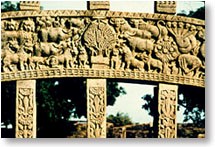
- The passage is enclosed by a railing having four gateways facing the four directions. The Buddhist carvings on both faces of the architraves and on all sides of the uprights of these gateways are remarkable for their crowded scenes, perspective and pictorial effect in stone.
- In a part of the Eastern Gate of the Sanchi stupa there is a scene depicting a bracket figure of a Vrikshika or wood nymph. In this we can see that the sculptor has advanced a great deal since he had carved the frontal, though to a certain extent rigid, human figures, in the 3rd-2nd century B.C.
- The Vessantara Jataka from Goli, belongs to the 1st century A.D., in his previous birth Buddha was Prince Vessantara, who was never tired of giving away everything he had in charity.
- Of a later date, circa first century A.D. and more mature in skill, are the carvings from Karle. Noteworthy are the Dampati and the Mithuna figures as also the pairs riding the magnificent elephant crowning the pillars forming imposing colonnades. The figures are more than life size and are represented with powerful and muscular physique.
- A famous carving depicts the adoration of the feet of the Buddha by four women and belongs to the second century A.D. from Amravati.
- A relief medallion from Amravati belonging to the second century A.D. is a masterly representation of a scene showing the subjugation or taming of Nalagiri, a mad elephant let loose on the Buddha in the streets of Rajagriha by his wicked cousin, Devadatta. The great commotion and anxiety caused by the rush of the mad elephant at the Buddha is forcefully brought out and thereafter the furious animal is shown calm and kneeling at the feet of the Master.

Taming of Nalagiri Elephant, Amaravati 1
- There is a richly sculptured slab from the Buddhist stupa which once existed at Amravati. Another remarkable example of the elegant style of Amravati in the 2nd century A.D. is seen in the beautiful railing cross-bar.
- The subject, treated here is the presentation of Prince Rahul to his father, the Buddha, when the latter paid a visit to his family in his former palace.
- The presence of Buddha is here symbolised by the empty throne, his footprints, the wheel of the law and the triratna symbol. On the right are his followers clad in robes and on the left, the inmates of the palace. In the distance, behind the curtain, are seen an elephant, a horse, and attendants.
- The Ayaka or cornice beam with a sequence of subjects is a typical example of the art from Nagarjunikonda.
- The beam has been divided into rectangles displaying scenes from the Jataka tales interspersed with loving couples within small compartments made by the spacing pillars.
- There is a multitude of humanity represented, palace war and loving scenes representing both male and female figures in a variety of animated postures.
Indo-Greek, Indo Scythian and Kushan kings
- After Alexander’s invasion of India in 326 B.C., the Indo-Greek, Indo Scythian and Kushan kings ruled over its north-western territories and under their patronage emerged a distinct style of sculpture, popularly known as the Greco-Roman, Buddhist or Gandhara art.
- It was a product of the combination of Hellenistic, West Asiatic and native elements. Greek and Roman techniques, modified according to Indian requirements, were employed in fashioning the Gandhara sculpture which truly represents Indian culture in a Western garb. The subject-matter treated is predominantly Buddhist. Its area extended from Takshila in India to the Swat Valley in Pakistan and northwards to areas in Afghanistan.
New Changes:
- The first century of the Christian era’s revolutionary change, had far-reaching effects, not only on the art of India, but also on the artistic development of Buddhist countries of Asia.
- Buddha who was hitherto designated only by a symbol, was conceived in human form. His person was given some of the 32 suspicious bodily signs associated with the Mahapurushalakshana, such as the protuberance of the skull, the hair-knot, bindi between the eyebrows and elongated ears.

Head of Buddha, Gandhara period, 2nd c 1
- This change came about as a result of the new changes that had crept into the religious outlook of Buddhism due to the influence of the Devotional School of Hindu Philosophy, requiring the worship of personal gods.
- It must have exercised profound influence on the religious approach of the masses towards Buddhism. The image becomes henceforth the main element of sculpture and worship.
- Possibly, the emergence of the image of Buddha in Gandhara and in Mathura was a parallel development. At Mathura it clearly emerges from the Yaksha tradition. The Gandhara image might seem to resemble Apollo in some extraneous forms and does look characteristically Greco-Roman in drapery, but even there most of the images represent Buddha as seated in the typically Indian Yogic posture, a feature completely unknown to the Hellenistic tradition of art.
- The relief panel showing Buddha’s Great Departure is a fine example of Gandhara art of the 2nd century A.D. Forsaking his wife, child and future kingdom in the quest of eternal bliss, prince Siddhartha is shown riding away on high favourite horse, Kanthaka, whose hoofs are lifted by two Yakshas to prevent the sound being heard by his family.
- His groom Chhandala, holds the royal umbrella over his head. Mara, the Evil one, along with a couple of his soldiers and the citygoddess are urging the Prince to abandon his pious intention. This incident, which was a turning point in the life of Gautama, is effectively portrayed.
Bodhisattva:
- Another typical example of Gandhara art of 3rd century A.D. is the figure of a standing Bodhisattava. His right hand is shown in the gesture of protection. He is wearing a rich turban, a string of amulets across his body, and strapped sandals on his feet. The pedestal contains a pair of Corinthian pillars. The athletic figure wearing a moustache, the heavy drapery folds of the garments and the strapped sandal all reveal the Greco-Roman influence.
The Kushanas:
- The Kushans, who came from Central Asia, ruled over vast territories of the north from the 1st to the 3rd century A.D. During their regime, Mathura, was throbbing with great artistic activity, and its workshops even catered to the outside demands for sculpture.
- Now icons of Brahmanical gods and goddesses and Buddhist and Jain divinities, which characterized the subsequent evolution of Indian art were produced experimentally. Some magnificent portrait studies of the Kushan emperors, together with several noblemen and women were executed during the period in the characteristic red and red-speckled sandstone of Mathura.
- The Buddhist religion greatly flourished under the patronage of Kushan emperors, and several images of the Buddha and Bodhisattavas were produced after the earlier Yaksha types.
Difference between Budha and Bodhisattva
- Here, we may point out the difference between a Buddha and Bodhisattava. Buddha is one who has attained the enlightenment of supreme knowledge, while the Bodhisattava is still a
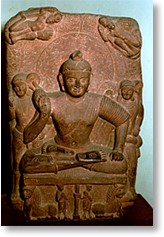
Seated Buddha, Stone, Mathura, Uttar P 1
candidate for it.
- A typical example of the image of Buddha, as it was evolved by the Kushan sculptor in the 2nd century A.D. shows him seated cross-legged on a lion-throne, under the Bodhi tree, with his right hand in the gesture of assuring protection, while the left is placed on the thigh.
- The eyes are wide open and the protuberance on the skull is indicated by a single curl coiled to the left. The hands and feet are marked with auspicious symbols. Two fly-whisk bearing celestials, standing on either side, are shown above. This type of image of the Buddha reached perfection in the Gupta age, three centuries later.

